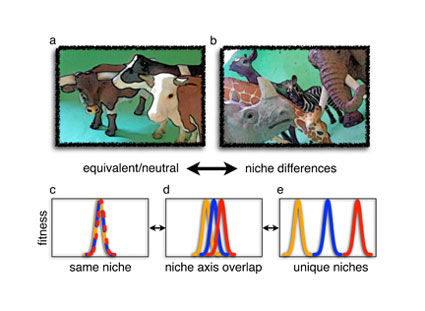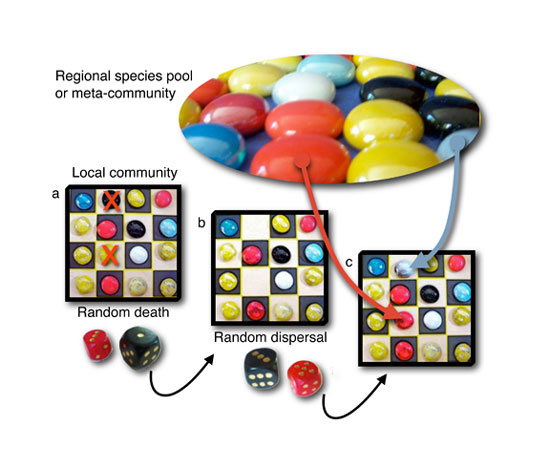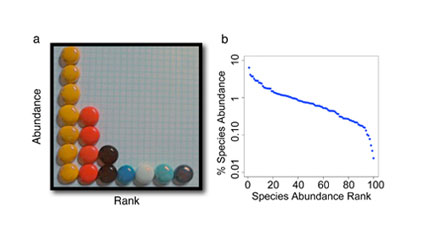« Prev Next »


Building on foundational ideas described in island biogeography and the neutral theory of molecular evolution, the neutral theory of species diversity makes the provocative assumption that all individuals are ecologically identical, and that niche differences are not needed to explain biodiversity patterns. Individuals of certain species may all share characteristics that make them look or function different from other species, but those differences do not influence diversity. An individual in a community interacts with and experiences its neighbors as though they were exactly the same, regardless of species. This assumption of equivalence is the essential feature of neutrality, which differs from typical niche-based assumptions that an individual’s fitness depends on who its neighbors are: are they stronger or weaker competitors or do they belong to different species with different niche requirements (Figure 1)? Neutral theory predicts that species have perfectly overlapping niches — at the other extreme would be species with unique, non-overlapping niches. Real communities, of course, likely represent neither of these extremes but are somewhere in the middle (Figure 1). What neutral theory forces us to ask is how ecologically different are species, and how important are those differences for determining biodiversity?
How Neutral Theory Works
Under the neutral theory, highly diverse communities of equivalent species arise because chance extinctions are balanced by speciation. Specifically, the assumption of fitness equivalence combined with stochastic or random processes that include death, immigration from a regional pool of species, and speciation can lead to species-rich communities (Figure 2). As an example, imagine a field, which will be the local community, made up of many species of plants. Plants in the surroundings will represent the regional species pool. The field is thus part of a larger collection of plant communities called a meta-community. Individuals in the local community die at random and create openings for seeds to grow. Individuals from the meta-community, and from the local community, randomly disperse their seeds into the field (Figure 2). If there are more individuals of some species than others they will contribute more seeds than will rare species, but each individual seed has an equal chance of establishing. Individuals are in that sense competing for open sites. If dispersal from the meta-community is strong, the local community will look like a small version of the region; if dispersal from outside is weak, random deaths and extinctions combined with random mutations and speciation will cause the local community to drift and differ more and more from other communities over time, but in an unpredictable way. This random change in species abundance over time is termed ecological drift. There can be a limit to the number of individuals in the local community — this is known as a zero sum assumption: if the community is full, a new individual can only establish if another one dies and makes space (Figure 2).

What Neutral Theory Is; What It Isn’t
Although dispersal, stochasticity and speciation are not unique to the neutral theory, neutral models are more interesting and useful when we add in things like dispersal and stochasticity. For this reason, neutral theory is often described as a “dispersal-assembly” theory or a “stochastic” theory, even though neither dispersal nor stochasticity is a feature uniquely or necessarily neutral. Dispersal and reproductive traits are in fact another way that species can differ in their fitness, and how organisms move through space can be an important component of a species’ niche. Consider the enormous variety shown by flowering plants in their fruits (coconuts to dandelion seeds) and the diverse ways plants can disperse by wind, water or animals, as well as their different mating strategies, germination and pollination mechanisms. Dispersal may often be highly unpredictable, but it is not necessarily neutral.
Dispersal and speciation processes in neutral models can lead to highly diverse communities. But the coexistence of species in neutral communities is unstable — there are no mechanisms that cause one species to remain dominant or prevent rare species from going extinct. Because neutral processes are driven by random events, and because all individuals are competitively identical, their abundances either increase or decrease purely by chance. In a closed system, stable coexistence, or long-term persisting species, can only occur when there are niche differences that cause individuals to compete most strongly with individuals of their own species compared to those of other species. Niche-based stabilizing mechanisms limit the growth of species when they become very abundant, while at the same time stabilizing mechanisms allow rare species to increase because they enjoy higher fitness when surrounded by neighbors of different species with whom they compete less strongly.
Pattern versus Process

The Utility of Neutral Theory
Summary
References and Recommended Reading
Adler, P. B., HilleRisLambers, J. et al. A niche for neutrality. Ecology Letters 10, 95-104 (2007).
Alonso, D., Etienne, R. S. et al. The merits of neutral theory. Trends in Ecology and Evolution 21, 451-457 (2006).
Bell, G. Neutral macroecology. Science 293, 2413-2418 (2001).
Chase, J. M. & Leibold, M. A. Ecological Niches: Linking Classical and Contemporary Approaches. Chicago, IL: University of Chicago Press, 2003.
Hubbell, S. The Unified Neutral Theory of Biodiversity and Biogeography. Princeton, NJ: Princeton University Press, 2001.
McGill, B. J. A test of the unified neutral theory of biodiversity. Nature 422, 881-885 (2003).
McGill, B. J., Maurer, B. A. et al. Empirical evaluation of neutral theory. Ecology 87, 1411-1423 (2006).
Silvertown, J. Plant coexistence and the niche. Trends in Ecology and Evolution 19, 605-611 (2004).
Tilman, D. Niche tradeoffs, neutrality, and community structure: a stochastic theory of resource competition, invasion, and community assembly. Proceedings of the National Academy of Sciences, USA. 101, 10854-10861 (2004).






























